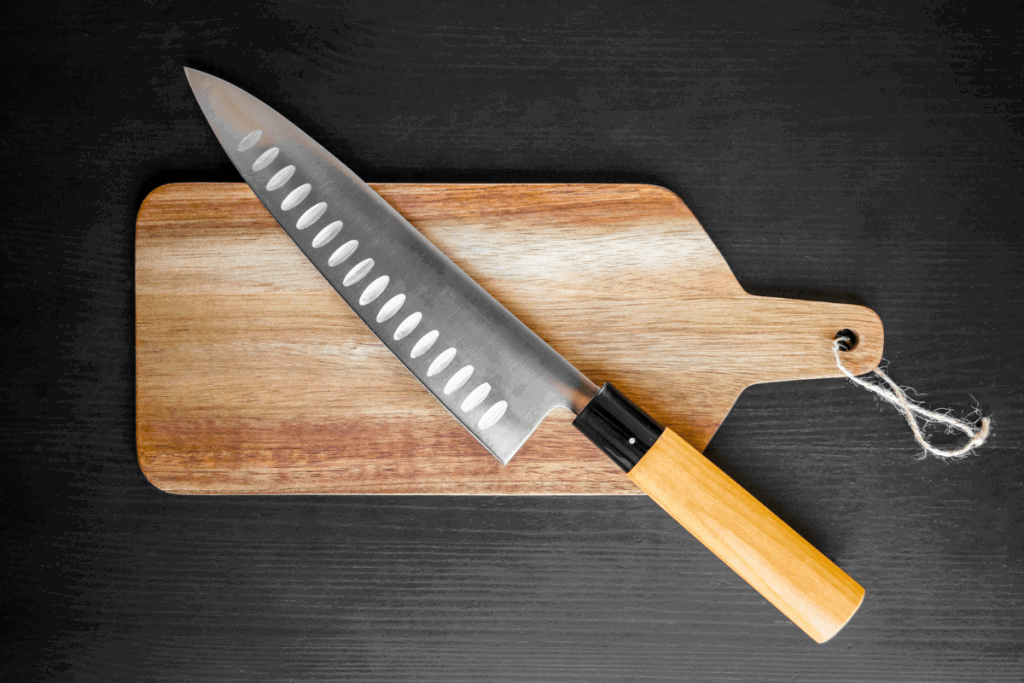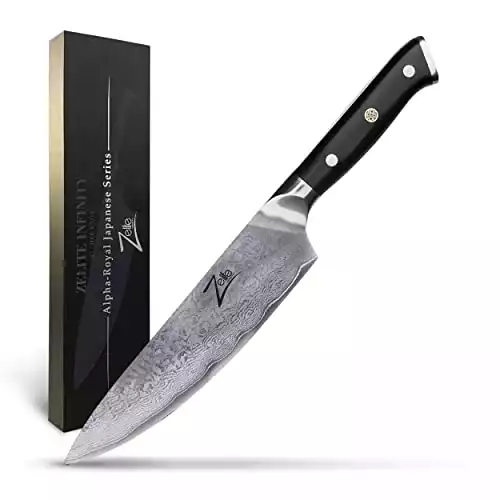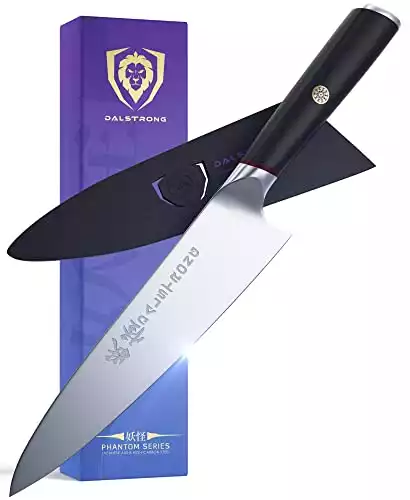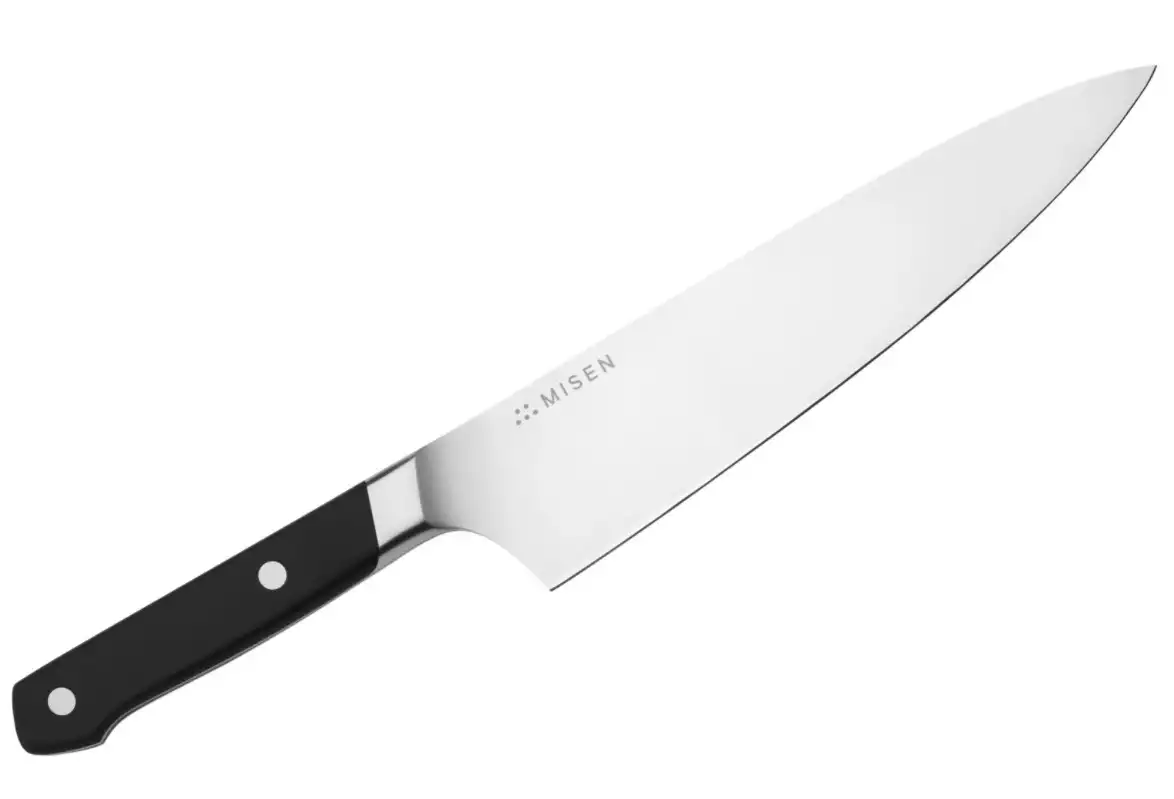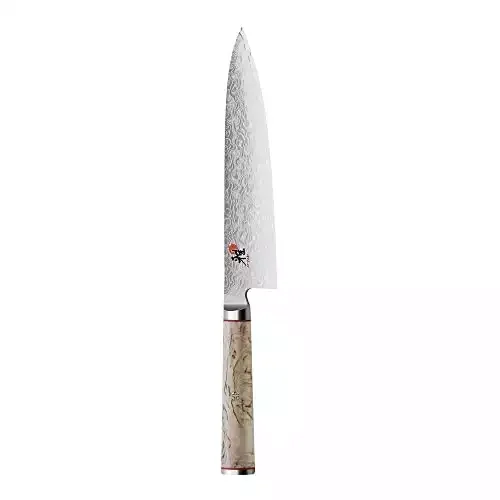Although they’re only about a century old, the Gyuto is the best Japanese knife for most home chefs in the Western world.
Its design was inspired by the classic French chef’s knife, which makes the gyuto incredibly easy to learn compared to traditional Japanese knife designs. At the same time, the gyuto offers a thin blade, hard steel, and incredible craftsmanship that are the hallmark of Japanese cutlery.
As part of our larger series on Japanese knives, we brought several popular gyuto knives into our Test Kitchen for 6 months of intensive side-by-side testing. Although there wasn’t a “one size fits all” winner, some brands were clearly better than others. The Shun Classic gyuto is our top recommendation for most people.
In this article, you’ll see the full results of our testing and comparison. We’ve included loads of photos of these knives in action and a few alternative recommendations that may be a better fit for some people with specific use cases.
Test Kitchen Stats
| Number of knives tested | 15 |
| Length of testing | 6+ months |
| Japanese chefs consulted | 3 |
| Pounds of onions diced | > 250 lbs |
| Number of testers | 4 |
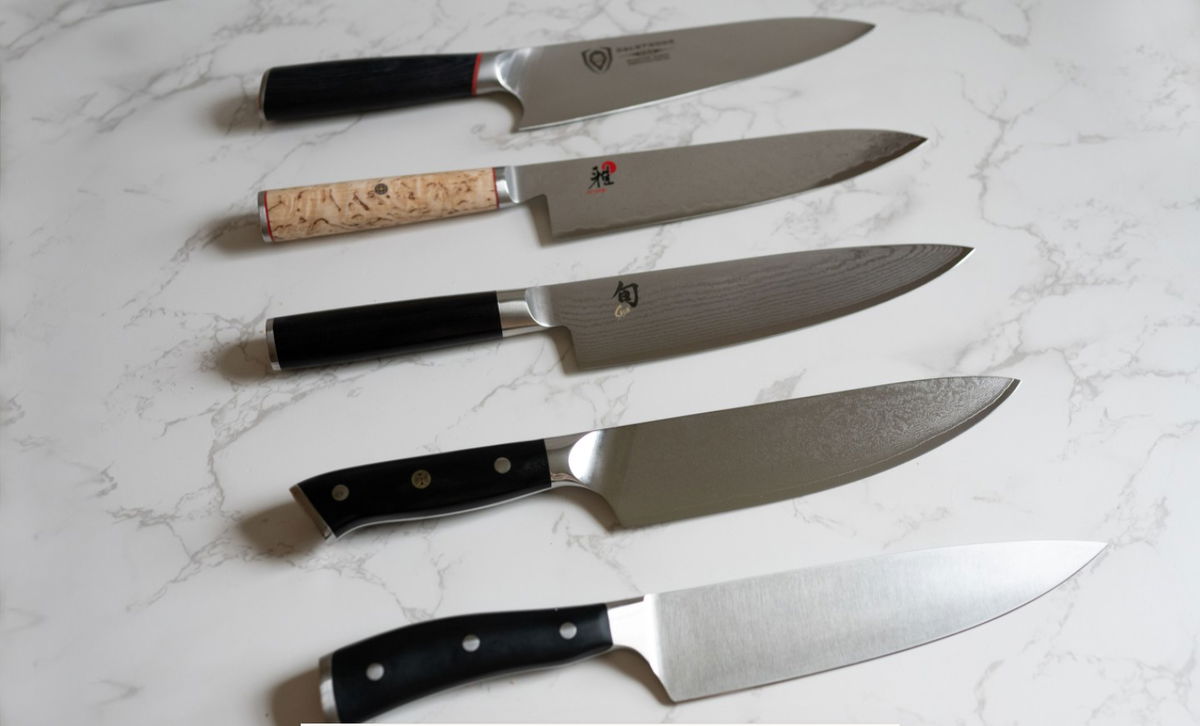
In This Article
Comparison Of The Best Japanese Knives
Shun | Miyabi | Oishya | Zelite | Dalstrong | Misen | |
Knife | Classic 8" Chef Knife | Birchwood 8" Chef Knife | Sakai Kyuba 8.5" Gyuto | Zelite Infinity 8" Damascus Chef Knife | Dalstrong Phantom 8" Chef Knife | Misen 8" Chef Knife (2nd Gen) |
Ranking | 1st | 2nd | 3rd | 4th | 5th | 6th |
Ratings | 9.5/10 Best Overall | 9.3/10 High End | 9.3/10 Best Artisan | 8.2/10 Western Design | 7.6/10 Flat Blade | 8.1/10 Best Value |
Weight | 191g | 177g | 159g | 288g | 189g | 233g |
Heel Depth | 44mm | 44mm | 46mm | 47mm | 48mm | 48mm |
Blade Angle | 16 degrees | 9.5 degrees | 17 degrees | 12 degrees | 13 degrees | 15 degrees |
Damascus Layers | 68 | 101 | 46 | 66 | 0 | 0 |
Read Review |
The 6 Best Japanese Knives From Our Test Kitchen
Shun Classic Chef’s Knife
The company behind Shun has been making blades in Japan’s “city of blades” for over a century. But it was only in 2002 that they introduced the Shun imprint to western kitchens.
The business absolutely took off, and twenty years later is among the biggest names in the world of kitchen knives. They bridged the gap between traditional Japanese swordmaking and the modern kitchen.
The Shun Classic gyuto is always our first recommendation for anyone who’s just getting into Japanese knives. It’s a surefire fit for most home chefs.
While the blade is crafted in a traditional Japanese style, several of the design decisions will feel comfortable if you’re more familiar with using a western-style chef knife. The balance is great, it gets (very) sharp, and the price is right.
What we like
- Takes a sharp edge and keeps it.
- Knife shape and weight are beginner friendly.
- At the intersection of performance and value
What We don’t
- Other options are more unique, flashier aesthetic.
- Not a great choice for left-handers.
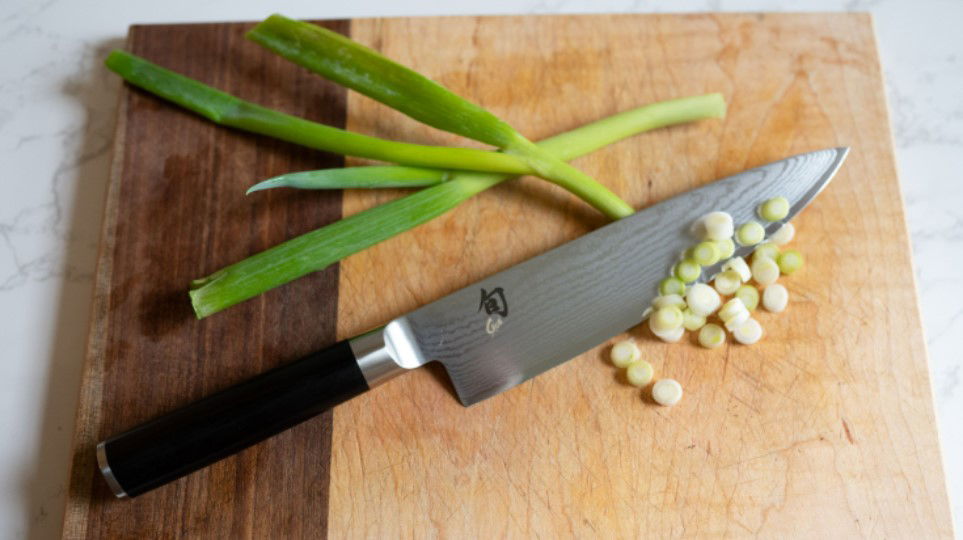
Japanese Steel
The Shun Classic gyuto bares the hallmark of a good Japanese knife – the steel is thin, exceptionally hard, and sharp. It doesn’t dull easily, either.
This blade is constructed in layers.
At the center is VG-MAX high carbon steel, which has a Rockwell hardness of 60. This metal forms the knife’s cutting edge. It’s surrounded by 34 layers of Damascus-folded stainless steel on either side.
The gyuto we trialed in the Test Kitchen arrived exceptionally sharp. And it held an edge at least as long as any of the other knives we tested. We re-sharpened every product at 3-month intervals, even though the Shun probably didn’t need it yet.
Western Blade Design
Although the Classic gyuto is fashioned using traditional materials and forging, several aspects of the blade design are geared toward a US audience.
Unlike many traditional Japanese knives, this one is sharpened with a symmetric 16-degree double bevel. This means that the sharpening angle is identical on either side of the cutting edge. The angle and symmetry are similar to what you’d find in a European design.
While a single-bevel blade can get sharper than this knife, there are significant benefits to usability and maintenance with a double-bevel.
The shape of the blade is also rounded and more akin to the shape of a European knife. In the Test Kitchen, our team found this was very helpful because it makes rock cutting and chopping much easier.
Traditional Japanese knives often take a flatter edge, which is great for straight slicing cuts but eliminates the rocking motion. You can practice slicing or pushing cuts with this knife, but we’ve found that most home chefs in the west gravitate toward rocking.
D-Shape Handle
Shun uses a traditional D-Shaped handle for this knife, made of Pakkawood. It’s asymmetric and oriented toward right-handed users.
While this knife didn’t feel as natural to hold for our left-handed tester, it was still among her favorites.
The look of the handle is sleek and minimalist. It’s capped with a tapered stainless steel half-bolster, which is the balance point for the knife.
We found the grip worked well for testers who preferred a pinch grip, and those who gravitated toward a handle grip.
The Price Is Right
One reason this knife took our best overall pick is that the balance of value to cost is excellent.
It’s true you can spend half as much on a Japanese chef knife, or double. Shun Classic is priced at the rough median of what you can expect to find from other options.
This knife consistently and significantly outperformed lower-dollar knives. That was the opinion of our testers, cited by experts and owners we interviewed, and also what you can see from the raw material data about this knife.
A more expensive knife may get sharper or retain a better edge, but we found the performance benefits of spending more are incremental at best. This knife can handle the pressures of a home kitchen and is a favorite of many professional chefs.
If you care about uniqueness or aesthetics, spending more money can make a difference. I’ll give you a few examples of aesthetic upgrades (Miyabi), and obscure knives (Oishya) below.
If your priorities are to get a top-performing knife at a fair price then look no further. It’s classy and minimalist. And this knife will do everything you’d expect from a Japanese knife.
Miyabi Birchwood Chef Knife
An offshoot of the venerable German knife company Zwilling, Miyabi combines the best in traditional Japanese craftsmanship with German technology and attention to detail. We brought the Miyabi Birchwood into the Test Kitchen.
Made of a special steel alloy known as SG2, this gyuto is the hardest and sharpest knife on this entire list. Where most German knives reach around 57 on the Rockwell hardness scale, and many Japanese blades don’t top out over 61, Miyabi’s gyuto hits a remarkable 64!
This is also a knife you’ll want to display proudly. The shape, Damascus folds, and birch wood handle beg for attention.
If not for the price, this would be the top knife on our list. Our team rated it tops in every other category. If it’s in your budget, this is a great choice.
What we like
- Visually stunning – a work of art.
- The sharpest knife we tested.
- Lightweight and easy to handle.
What We don’t
- You can get a similar-performing knife for less.
- Miyabi branding printed on the handle, although it does wear off.
- Knives are made in Seki, but the parent company is German. We felt this made the knife’s story slightly less interesting.
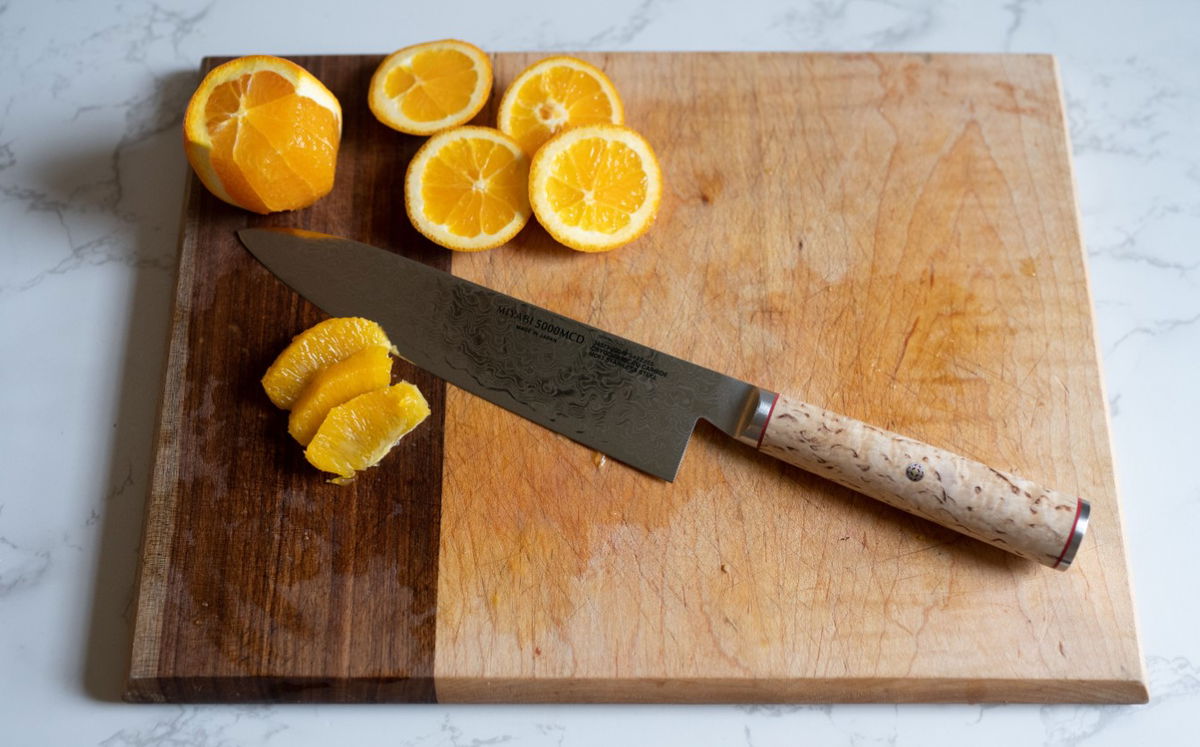
101 Damascus Layers
The Miyabi Birchwood has almost twice as many Damascus layers comopared to the Shun Classic, which was our top pick. But does it really matter? Yes and no.
By using Damascus forging, the knife maker is able to sandwich a corrosive high carbon steel between layers of protective stainless steel. It makes for a sharper cutting edge, better edge retention and less risk of staining or chipping.
The folded look of Damascus steel is also incredibly beautiful. For most people buying one of these knives, the aesthetic is part of the consideration. No other knife we tested was as clearly and beautifully damascus folded as the Miyabi.
When laid side-by-side with other knives, it’s sure to be the first thing that grabs your eye.
In our tests, we found that the 100 layers of SG2 steel didn’t stain or corrode.
Sharpest Edge
The Miyabi Birchwood’s MC63 microcarbide powder steel core took the sharpest edge of any knife we tested.
It’s not surprising that it also ratest as the hardest steel on the Rockwell scale, at 63.
MC63 will take on an especially steep edge, to 9.5 degrees. This means the total cutting angle is 20 degrees. Compare that to most other blades which take a 30-40 degree cutting angle.
Not only does this work out in theory, the Birchwood was also consistently the best at taking and holding a sharp edge in the Test Kitchen. While many of the other knives performed similarly, this knife was noticeably better.
We did have some difficulty self-sharpening, and would recommend taking this knife to a pro sharpener once every 6 months if you aren’t comfortable with a whetstone. Most farmers markets have one, charging $1-2 per inch of blade, and can finish the job while you do your shopping.
Birch Wood Handle
Like the blade, the handle on this knife is also stunning. It’s made of birch wood, fashioned in a traditional D-Shape.
While the handle is intended for right-handed users, we found it was also the favorite blade of our left-handed tester. It has a slender and delicate feel, and is simple to maneuver. It’s very light.
The grain structure on the wooden handle will catch your eye at a distance, and there is some great up close attention to detail there too. A 20 piece mosaic is pressed into the side, made of steel, copper and bronze.
All of the edges are perfectly flush, and the handle tapers down to the blade with a half bolster. This provides great balance at the bolster, and an easy platform to grasp by the handle or with a pinch grip.
Oishya Sakai Kyuba Chef's Knife
If you’re into the obscure and beautiful, Oishya offers hand-worked traditional knives unlike anything your friends have in their kitchen. We brought their Sakai Kyuba gyuto into our test kitchen.
Although the label is new, the blades are produced by a master blacksmith in Sakai, Japan using a 600 year old production method. It takes more than 3-months to produce each individual blade.
The handles are stunning and one-of-a-kind, made from 2000 year old European bog wood. It’s shaped into the traditional octagonal style and hand dyed.
Like everything else about this knife, the company is unique. It’s woman-owned, which is rare in this industry. They got their start by doing things differently, and it shows in the way they do business and the unique presentation of their products.
If you’re the type of person who fills your life with products that have a story behind them, or you need it to be unique – look no further. This gyuto mixes function, fashion and lifetime design.
What we like
- Exceptionally unique look, handmade feel, and a great story.
- The balance is set forward over the blade, making for easier maneuvering and chopping in a pinch grip.
- High attention to detail in the design of the blade, handle and how it’s packaged.
What We don’t
- This is art, and art isn’t cheap.
- The handle shape and forward-set balance makes it less ergonomic if you prefer a handle grip.

Hand-Hammered Blade
Hand-hammered steel is a core element of traditional Japanese bladesmithing. It’s an intensive process that requires a lot of time, labor and temperature.
The benefit is a thinner, lighter blade. At 159g, the Oishya gyuto was the lightest blade we tested even though it was ½” longer than every other knife.
Not only does hand-hammering provide equivalent strength in a more petite package, it also looks incredible. Even though some of the other knives we tested were also hand-made, no other blade was as clearly made in love as this one.
Every time you pick up this knife, you can feel it. From the 366 visible hammer strikes, to the damascus tree rings, and the hand-carved Kanji (“Sakai Kyuba”) on the blade.
Wa Handle
If you like to use a pinch grip, you may have noticed that Western-style handles are heavy and the design features get in the way.
Wa handles are lighter, which compliments the thin steel of a Japanese blade and shifts the balance forward off of the handle. In the Test Kitchen, we found the forward balance and straight handle shape was conducive to a pinch grip. This makes chopping and maneuvering the knife easier, especially if you’re working on a high volume of precision cuts.
The handle design is octagonal, which provided an excellent grip for both right and left handed users. Most of our testers who preferred a handle grip, didn’t like this design as much since it was missing the curvy handle ergonomics you might get with a western handle.
VG-10 Steel
While this was not the sharpest knife we tested, it was among the top tier. It performed similarly to the Shun Classic for sharpness and edge retention.
Oishya uses VG-10 high carbon steel for the core of the knife and cutting edge. This is one of the leading materials you’ll find across many brands of Japanese cutlery. It has a Rockwell hardness rating of 62.
Each side of the blade is sharpened to a cutting angle of 17 degrees, so the total cutting angle is 34 degrees. This was about average among the knives we tested.
The cutting core is surrounded by 46 Damascus layers of stainless steel. The folded pattern is bold on the knife exterior between the hand hammering and cutting edge.
Ancient Wood
The ornate handle sets this knife apart.
The collar material comes from ancient oak bog wood. This wood has been effectively preserved for 2000-5000 years because it was buried deep in a marsh where no oxygen was present to decay it. The heel wood is a maple burl which takes on an intricate swirling grain.
It’s hand dyed and no two handles are exactly the same.
Our team had mixed reactions to the handle before it arrived. Based on the product photos, some people loved it while others found it less appealing.
When the knife arrived to the Test Kitchen, everyone loved the swirling green dye. It was lighter than we expected and offered a firm grip, even when wet. And it was unlike anything else in the kitchen.
Misen has been making direct-to-consumer kitchenware for nearly a decade. You may have heard of the super-successful Kickstarter campaign to launch the brand.
The company philosophy is to offer premium products at a discount price by cutting out middlemen. In that spirit, they launched kitchen cutlery in 2016.
We tested Misen’s second generation chef knife, which replaced their initial production design in 2019. Compared with their early knives, the new design features harder steel and changes to blade shape, bolster and handle.
What we like
- For the value you get, the price is right.
- French shape blade makes rocking and up-down cuts possible.
- Free sharpening for the life of your knife.
What We don’t
- The bolster design isn’t as comfortable as the first generation version.
- High quality steel for a low price.
- Many of their knives (ours included) badly needed sharpening out of the box.
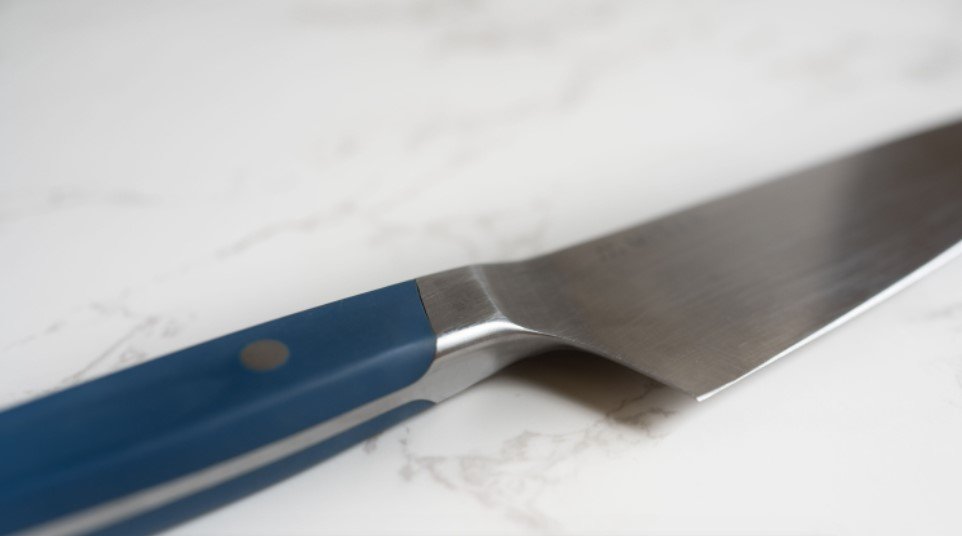
Blade Shape
Misen presents this knife as a happy medium between European and Japanese shaped blades. From experience in the Test Kitchen, the shape feels most distinctly French.
The blade does have some roundness, but is really long and drawn out before it curls upward. The tip of the knife draws down slightly from the heel.
As a result you can rock cut with this knife, but the flat belly is better oriented for up-and-down chopping.
Upgraded Steel
For the 2.0 version of this knife, Misen upgraded from AUS8 to AUS10 steel. Both are similar types of Japanese high carbon steel, with AUS10 having a higher carbon content.
The benefit of the new steel is greater hardness. AUS10 gets a Rockwell hardness rating of 58. To be fair, it is one of the softer blades we tested, while also being harder that their original production model.
A harder blade yields better edge retention and, usually, a sharper edge.
We found the sharpness and edge retention of this knife to be a good value for the money, but significantly less effective than any of our top 3 picks.
What’s more, the knife was dull out of the box. If you sharpen your own knives this shouldn’t be a big deal. Misen does offer lifetime mail-in sharpening on their products. But it’s not exactly convenient to order a blade that needs to be mailed back for sharpening before you can use it.
Boxy Handle
The handle is boxy and minimal. It has some ergonomic curves like a German knife, but is mostly straight like a Japanese knife. It works ok for both handle and pinch grip, although it’s not dynamite for either.
In short, you don’t some of both worlds, but not the best of either.
When pinch gripping this knife, we found that the spine of the knife didn’t feel great. The edges weren’t well rounded, so it tended to cause soreness and eventually blisters after repeated use. This phenomenon dissipated as our hands grew callous on the inside of the forefinger from continuous use.
Value
This knife wasn’t great in any one rating area, but it was pretty good across all of them. The main driver for keeping it on our list was value for the money.
The Misen chef’s knife mimics the features and performance of a $150 knife, for half the cost. While we still think the Shun Classic is a better pick, if you’re on a budget OR if this is a knife you don’t intend to use often then Misen may get you the most bang for your buck.
Dalstrong Phantom Chef Knife
No recent knife making company has created quite as much of a stir as the Canadian company, Dalstrong. Since entering the scene, they’ve committed to making knives in both traditional and innovative styles, using the same top quality materials as competitors.
Yet somehow, they’re offering their knives for crazy cheap prices — leading some knife enthusiasts questioning their quality.
Despite the very “creative” names, most of Dalstrong’s kitchen knife offerings stand up to close scrutiny. We tried out several of their knives, and found that the Phantom gyuto, offers a good mix of traditional shape with modern design choices.
What we like
- The flat blade shape makes long slicing cuts easy to accomplish.
- Excellent quality of materials and construction.
- Comes with a great sheath, for safe drawer storage and travel.
- Price is very accessible.
What We don’t
- The shape isn’t a great fit for rocking cuts, like a western design.
- Most of us found the branding to be a turn-off.
- The handle is bulky, and the spine is thicker than other knives. Feels heavier and less petite, even though the overall size is smaller.
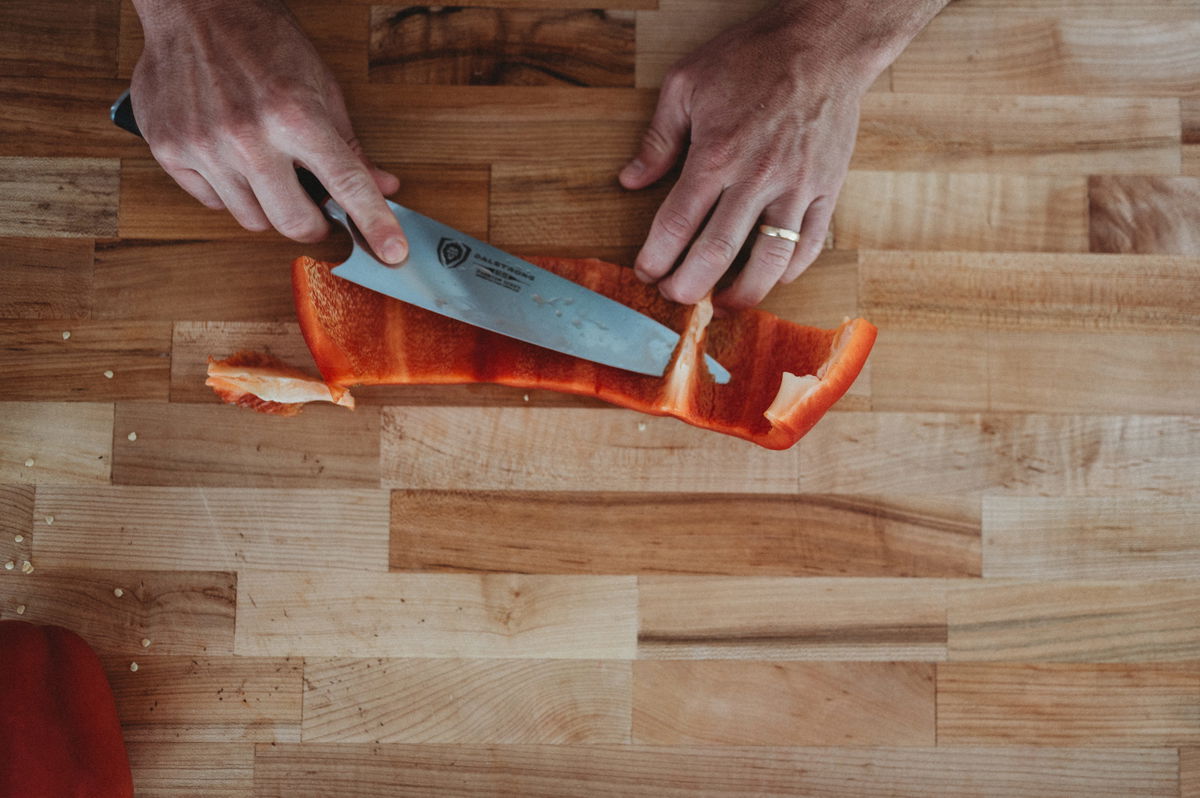
Modern Bolster
The Phantom series chef knife uses a traditional Japanese D-shaped handle, combined with a more modern half bolster design for excellent balance.
Everyone who tried this knife in the Test Kitchen found it harder to use, initially. But with a little practice we realized the shape and balance give this knife incredible control – almost like you’d get with a petty knife.
Blade Shape
The blade shape on the Phantom is deceiving. Although the blade is deeper at the heel of the knife than any other model we tested, it still comes across as feeling “short.” We found this was inconvenient for cutting thick food product, but very effective for shallow cuts.
The other aspect of blade design that drew mixed reviews from our testing team was the cutout a the back of the blade. This feature makes space to nest the middle finger during a pinch grip. It works better for some hands than others, and inspired a lot of love (or hate) for this design.
The cutting edge curves up slightly toward the tip of the knife, similar to a French knife design, only flatter. This feature was especially helpful for detail work, like de-stringing celery.
AUS8 Steel
The blade is made entirely of AUS8 Japanese steel, and forged in China, which helps to keep production costs down.
AUS8 has a lower carbon content than other popular knife steels like AUS10 or VG10, but it is similarly hard. It scores a 58 Rockwell hardness rating. This is among the softer knives we tested, but it still as hard as popular European brands like Wusthof.
In general we found this knife was slighly less sharp than others we tested, and only held an edge better than Misen among products in the Test Kitchen.
With that said, if you like the flat shape, then the difference in sharpness and edge retention shouldn’t sway you from this knife. Especially for the price.
Zelite Infinity Chef Knife
The Zelite Infinity chef knife is made with Japanese steel in a Damascus process. It’s sharp and holds a great edge. Everything else about it feels Western.
A relative newcomer to the kitchen knife world, Zelite uses the same tactics as Dalstrong to produce inexpensive knives — meaning that they source steel from Japan, but produce their knives in China to keep costs low.
If you like weighty German knives that are shaped for deep rocking cuts, but you also want the benefit of Japanese damascus steel, this is a great knife for you.
What we like
- The shape and weight means it handles like a Western knife.
- Blade depth (~47mm) is ideal for the deeper cuts like red meat and root vegetables.
- All of the edges are smooth and well-rounded.
What We don’t
- Handle is heavy, and can get slippery when wet.
- Some nice details, but not a high-aesthetic knife.
- Bolster shape is not well suited for a pinch grip.
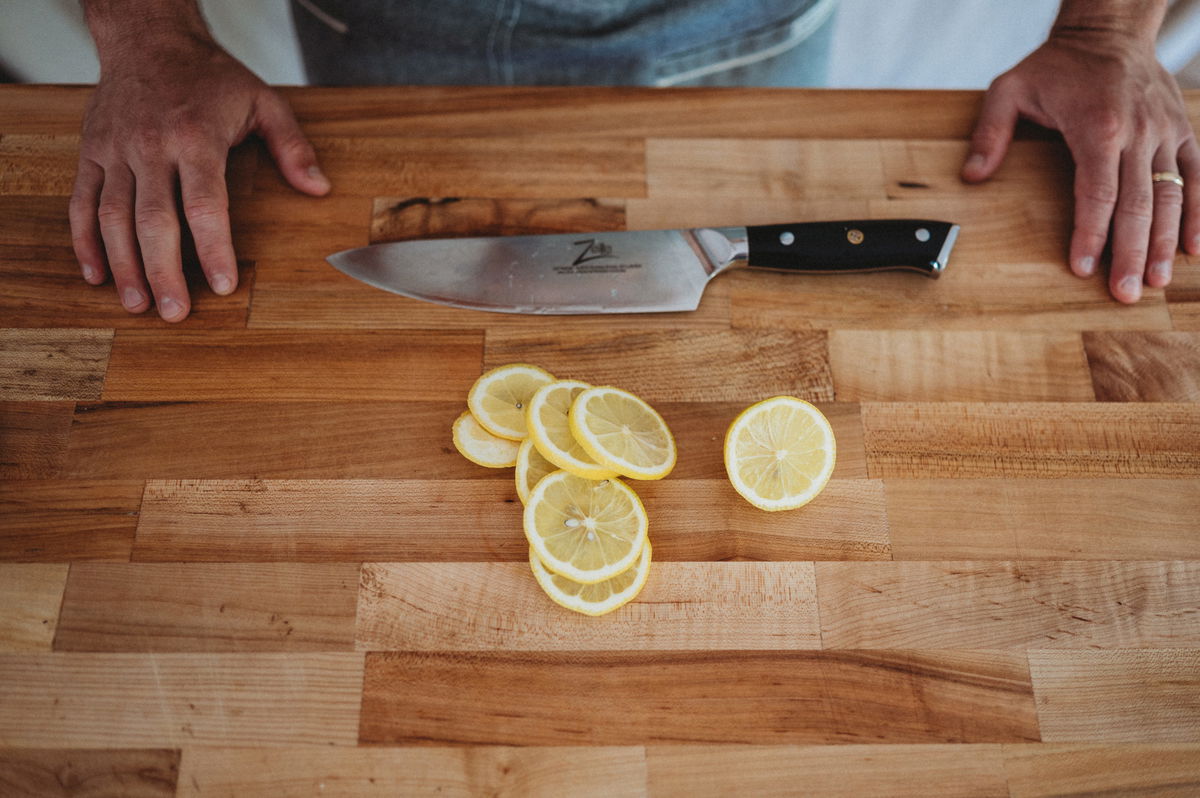
Deep Blade
Our Zelite Infinity chef knife had a deeper, heavier blade than any other Japanese knife we tested.
The blade depth at the heel of the knife is 47mm, which was especially handy when cutting red meat and root vegatbles with a handle grip. This feature was somewhat less convenient for testers who preferred a handle grip.
More blade means more metal. And more metal means more weight. This knife was 50% heavier than our top pick, which may be a turn off if you prefer a knife that is light and petite.
But, if you need a knife that will do some of the work for you on stubborn cuts, this is a great fit.
German Blade Shape
While many of the knives we tested had western-leaning design elements, the curved shape of this blade was noticeably more German than any of the others.
The blade shape lends itself to smooth rocking cuts, which many home chefs are more familiar with. We found it was less effective for push-and-pull slicing that is more characteristic of traditional Japanese cutlery.
Bulky Handle
Apart from the blade shape, a dominant characteristic of this knife is the bulky western-style handle.
There is some ornate detail there, but it doesn’t really match the aesthetic of the rest of the knife. The Damascus layers are very faint. The brass, copper and stainless steel mosaic on the handle is beautiful, but seems out of place.
From a performance standpoint, if you like a heavy knife with a solid handle grip, this is a better fit than any other option we tested.
Sharpness
Our knife was dull out of the box, but quickly took a sharp edge using a whetstone.
The 12 degree sharpening angle created a very sharp edge, but peak sharpness didn’t last for long. Maybe one month.
One thing that was interesting about our experience with this knife is that when it dulled, it was still functionally sharp. Just not to its peak ability.
Zelite uses an AUS10 carbon steel core, which has a Rockwell hardness of 61. This is similar to our top pick, the Shun Classic. Although we weren’t able to determine why peak sharpness was brief, we found that overall edge retention was similar to the Shun.
Other Brands We Didn’t Test
We believe the knife makers and brands listed above represent high-performing options for their respective categories. We picked these products out of the 15 knives that came into our test kitchen.
Our team was familiar with several other brands through cooking at home and working in professional kitchens. We hope to put each of these through rigorous testing in the years to come.
Here are a few other recommendations from our team that didn’t make it into the Test Kitchen yet:
- Masamoto makes an excellent Damascus steel gyuto, and their 9-inch slicer knives are quite impressive for preparing sushi.
- Kuma’s knives might be the most affordable way to get into Japanese knives and have been a beginner’s knife for a handful of chefs. Even their Damascus steel gyuto is inexpensive.
- Korin has a huge selection of Japanese knife styles, and their sharpening is top-notch. They represent around a dozen smaller Japanese knife brands through their online store.
- Yoshihiro has been making Japanese knives for over 100 years, but they are still a relatively new name in the United States knife market. Their direct-to-consumer approach helps them offer a very affordable product.
Methodology: How We Ranked Japanese Knives
We rated dozens of factors when selecting and testing these knives, from usability to maintenance to cost.
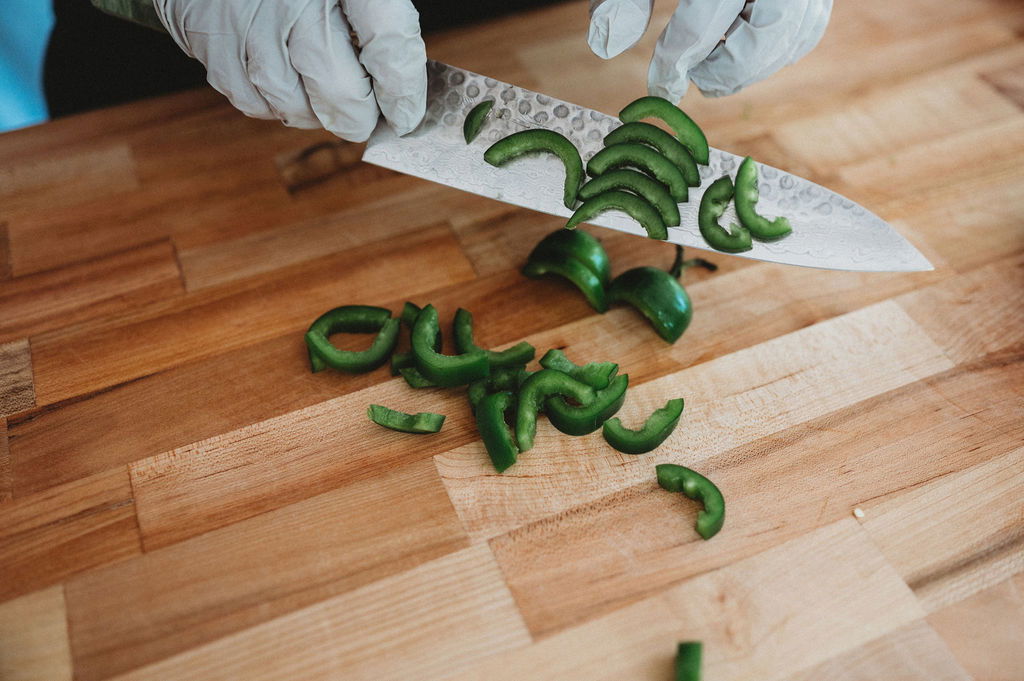
Type of Knife
For this article we only considered products that were designed in the Gyuto chef knife style.
In your average modern kitchen, a chef’s knife will perform more than 90% of prep tasks. It’s incredibly versatile and practical. Unless you are performing a highly specialized task, again and again, start with a chef knife.
In our view, the Gyuto is the best style Japanese chef knife for most Western kitchens. The shape was inspired by a traditional French chef knife, which means that it’s well-suited for the prep tasks that are most common in Western cuisine.
We covered a veggie-oriented chef knife called the Santoku, elsewhere. Although the design is similar, the flat shape and downward-sloping tip of a santoku makes it less suitable for meat prep and rock chopping – two of the most common use cases for home cooks in the West.
Double Bevel
The “bevel” refers to the way a knife is sharpened.
Many Japanese knives feature a “single bevel” design, meaning that they are only sharpened on one side of the blade. A single-bevel creates a sharper cutting edge which is helpful for long precision cuts.
While that may sound appealing we strongly recommend purchasing a “double bevel” knife instead. With a “double bevel,” the cutting edge is sharpened to the same angle on both sides of the blade.
It’s rare that a home chef will benefit from using a single bevel. They cut differently, don’t rock, are difficult to sharpen, and seem to be more brittle.
Corrosion Resistance
Most of the blades we tested were constructed using VG-10 steel, which is quite corrosion-resistant. But many traditional Japanese knives are made with high-carbon steel, which is more likely to stain and corrode.
Either way, if you leave a Japanese knife dirty or wet for an extended time, it will stain and rust.
During testing, one of our blades was left dirty overnight and had signs of corrosion when we returned the next day. For the least hassle, look for stainless carbon steel, clean and dry between uses.
Handle Design
A knife’s handle provides balance and gives you a safe, comfortable place to grip. Some handles are a thing of beauty, as well.
When using knives in the Test Kitchen, we ranked the comfort and security of the grip on each handle. We tested when the handle was wet with water, when it was dry, and with hands that were dirty and somewhat slippery from food prep.
Some Gyutos affix an ergonomic Western-style handle, but most use a more traditional octagonal or D-shaped design.
Among our testers, handle preference was highly subjective. If you don’t already have a preference, we recommend testing a few different handle styles before making a purchase.
Aesthetic
In traditional Japanese bladesmithing, every blade has a story to tell. Some knives are worked tirelessly for over a year by a single craftsman. They can be equally romantic as they are functional.
Part of our ranking considered the aesthetic qualities of each blade. There is no bargain bin Japanese chef knife. If you’re going to buy an expensive knife, then we believed it should look good too.
Place of Origin
Included in our current review, you’ll find several knives that were constructed with a Japanese design or materials, that aren’t strictly Japanese. Misen, Zelite, and Dalstrong (for example) are all produced in China using Japanese steel and the gyuto shape.
We’ve discovered that, in many ways, Japanese knives are an extension of Japanese history and culture. While other brands may create excellent Japanese-inspired products, there is no substitute for the craftsmanship that has been passed from generation to generation since at least the 14th century.
As part of our next update to this article, we’re working to incorporate more products produced by traditional Japanese craftsmen that fit the needs of the modern western kitchen.
